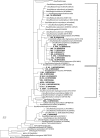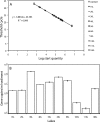Diversity, activity, and abundance of sulfate-reducing bacteria in saline and hypersaline soda lakes
- PMID: 17308191
- PMCID: PMC1855663
- DOI: 10.1128/AEM.02622-06
Diversity, activity, and abundance of sulfate-reducing bacteria in saline and hypersaline soda lakes
Abstract
Soda lakes are naturally occurring highly alkaline and saline environments. Although the sulfur cycle is one of the most active element cycles in these lakes, little is known about the sulfate-reducing bacteria (SRB). In this study we investigated the diversity, activity, and abundance of SRB in sediment samples and enrichment cultures from a range of (hyper)saline soda lakes of the Kulunda Steppe in southeastern Siberia in Russia. For this purpose, a polyphasic approach was used, including denaturing gradient gel electrophoresis of dsr gene fragments, sulfate reduction rate measurements, serial dilutions, and quantitative real-time PCR (qPCR). Comparative sequence analysis revealed the presence of several novel clusters of SRB, mostly affiliated with members of the order Desulfovibrionales and family Desulfobacteraceae. We detected sulfate reducers and observed substantial sulfate reducing rates (between 12 and 423 micromol/dm(3) day(-1)) for most lakes, even at a salinity of 475 g/liter. Enrichments were obtained at salt saturating conditions (4 M Na(+)), using H(2) or volatile fatty acids as electron donors, and an extremely halophilic SRB, strain ASO3-1, was isolated. Furthermore, a high dsr gene copy number of 10(8) cells per ml was detected in a hypersaline lake by qPCR. Our results indicate the presence of diverse and active SRB communities in these extreme ecosystems.
Figures



Similar articles
-
Effects of imposed salinity gradients on dissimilatory arsenate reduction, sulfate reduction, and other microbial processes in sediments from two California soda lakes.Appl Environ Microbiol. 2007 Aug;73(16):5130-7. doi: 10.1128/AEM.00771-07. Epub 2007 Jun 29. Appl Environ Microbiol. 2007. PMID: 17601810 Free PMC article.
-
Bacterial diversity and activity along a salinity gradient in soda lakes of the Kulunda Steppe (Altai, Russia).Extremophiles. 2008 Jan;12(1):133-45. doi: 10.1007/s00792-007-0117-7. Epub 2007 Nov 8. Extremophiles. 2008. PMID: 17989917
-
Sulfidogenesis under extremely haloalkaline conditions in soda lakes of Kulunda Steppe (Altai, Russia).FEMS Microbiol Ecol. 2010 Aug;73(2):278-90. doi: 10.1111/j.1574-6941.2010.00901.x. Epub 2010 May 4. FEMS Microbiol Ecol. 2010. PMID: 20500526
-
Haloalkaliphilic sulfur-oxidizing bacteria in soda lakes.FEMS Microbiol Rev. 2005 Sep;29(4):685-702. doi: 10.1016/j.femsre.2004.10.005. Epub 2004 Nov 20. FEMS Microbiol Rev. 2005. PMID: 16102598 Review.
-
Where the Little Ones Play the Main Role-Picophytoplankton Predominance in the Soda and Hypersaline Lakes of the Carpathian Basin.Microorganisms. 2022 Apr 14;10(4):818. doi: 10.3390/microorganisms10040818. Microorganisms. 2022. PMID: 35456867 Free PMC article. Review.
Cited by
-
Potential Activity, Size, and Structure of Sulfate-Reducing Microbial Communities in an Exposed, Grazed and a Sheltered, Non-Grazed Mangrove Stand at the Red Sea Coast.Front Microbiol. 2015 Dec 22;6:1478. doi: 10.3389/fmicb.2015.01478. eCollection 2015. Front Microbiol. 2015. PMID: 26733999 Free PMC article.
-
Microbial Diversity and Community Structure of Sulfate-Reducing and Sulfur-Oxidizing Bacteria in Sediment Cores from the East China Sea.Front Microbiol. 2017 Nov 7;8:2133. doi: 10.3389/fmicb.2017.02133. eCollection 2017. Front Microbiol. 2017. PMID: 29163420 Free PMC article.
-
Planktonic bacterial community composition of an extremely shallow soda pond during a phytoplankton bloom revealed by cultivation and molecular cloning.Extremophiles. 2013 Jul;17(4):575-84. doi: 10.1007/s00792-013-0540-x. Epub 2013 Apr 23. Extremophiles. 2013. PMID: 23609187
-
Desulfohalophilus alkaliarsenatis gen. nov., sp. nov., an extremely halophilic sulfate- and arsenate-respiring bacterium from Searles Lake, California.Extremophiles. 2012 Sep;16(5):727-42. doi: 10.1007/s00792-012-0468-6. Epub 2012 Jun 29. Extremophiles. 2012. PMID: 22744231 Free PMC article.
-
New sulfate-reducing bacteria isolated from Buryatian alkaline brackish lakes: description of Desulfonatronum buryatense sp. nov.Extremophiles. 2013 Sep;17(5):851-9. doi: 10.1007/s00792-013-0567-z. Epub 2013 Jul 24. Extremophiles. 2013. PMID: 23881259
References
-
- Boetius, A., K. Ravenschlag, C. J. Schubert, D. Rickert, F. Widdel, A. Gieseke, R. Amann, B. B. Jorgensen, U. Witte, and O. Pfannkuche. 2000. A marine microbial consortium apparently mediating anaerobic oxidation of methane. Nature 407:623-626. - PubMed
-
- Braid, M. D., L. M. Daniels, and C. L. Kitts. 2003. Removal of PCR inhibitors from soil DNA by chemical flocculation. J. Microbiol. Methods 52:389-393. - PubMed
-
- Brandt, K. K., and K. Ingvorsen. 1997. Desulfobacter halotolerans sp. nov., a halotolerant acetate-oxidizing sulfate-reducing bacterium isolated from sediments of Great Salt Lake, Utah. Syst. Appl. Microbiol. 20:366-373.
-
- Detmers, J., H. Strauss, U. Schulte, A. Bergmann, K. Knittel, and J. Kuever. 2004. FISH shows that Desulfotomaculum spp. are the dominating sulfate-reducing bacteria in a pristine aquifer. Microb. Ecol. 47:236-242. - PubMed
Publication types
MeSH terms
Substances
LinkOut - more resources
Full Text Sources

